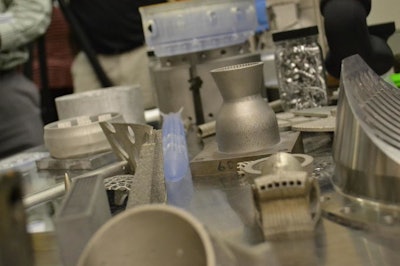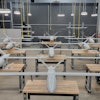
On a recent trip to NASA’s Marshall Space Flight Center, the aerospace organization provided some insight to the inner-workings of spacecraft manufacturing. At the Marshall Space Flight Center, they specialize in what can best be described as, the guts of a rocket.
After touring the U.S. Space & Rocket Center, which is also home to the fabled Space Camp (the only summer camp I ever desired as a kid), I was shown inside a portion of the soon-to-be-finished SLS rocket. Beyond the astounding number of cables and computers surrounding me, standing inside an area that would soon be launched into space was awe-inspiring – even if it was just a giant, curved rack system.
As the organization uses many custom-made low-run components, fabrication and manufacturing is a crucial step in the rocket development and construction process. This is why NASA has been leading the charge in the realm of additive manufacturing.
Additive manufacturing, or 3D printing, as it is often called, is saving NASA lots of money and weight, both of which are hard to come by in the aerospace arena, especially when traveling to low-Earth orbit. There have been several components that when redesigned for a 3D printer, instead of traditional casting, cost a fraction of the original design, and they work better.
That’s why, according to the panel of NASA experts, additive manufacturing will be absolutely necessary to get to the fourth planet in our solar system. At the moment, the first 3D printer in space, from the company Made In Space, is prepping to start fabrication of tools and other components while in orbit, so engineers can determine the tolerances and further evaluate the challenges of 3D printing in space.
Like many NASA experiments, the science that precipitates from manufacturing in space will not only help our civilization get to mars, but it will also add to the quickly growing launching pad of additive manufacturing and its uses.
I’ve been a skeptic for quite some time regarding the use of 3D printers as at-home fabrication units – after all, I’m not about to 3D print a cord-organizing clip for upwards of $6, when I can just run to the store and pick several up for a fraction of that. But, a conversation with an additive manufacturing specialist at NASA reaffirmed my zealotry for 3D printing.
The work NASA is doing in space, can and will end up helping small businesses achieve great things in the manufacturing realm. At this point, manufacturing can be expensive, especially if you have short runs. This is understandable, as the overhead cost to operate a manufacturing facility, as well as the cost to own/lease equipment, is a heavy financial burden. That’s why most start-ups and small businesses outsource their manufacturing.
As NASA demonstrates, in the not-so-distant future, 3D printing will have the capability to provide small businesses with the means to manufacture their own components without crippling costs or sacrifices when adapting to a larger manufacturer’s system.
This isn’t the same as at-home manufacturing, though similar, but it certainly provides more opportunity for start-ups and entrepreneurs without the daunting overhead costs of early manufacturing.
Do you think 3D printing will help entrepreneurial manufacturers? Will NASA’s additive manufacturing in space initiative get them to Mars while providing terrestrial businesses with valuable insight? Comment below.






















